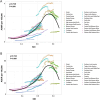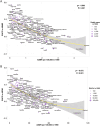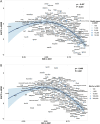The global burden of colorectal cancer attributable to high body-mass index in 204 countries and territories: findings from 1990 to 2021 and predictions to 2035
- PMID: 39634543
- PMCID: PMC11614609
- DOI: 10.3389/fnut.2024.1473851
The global burden of colorectal cancer attributable to high body-mass index in 204 countries and territories: findings from 1990 to 2021 and predictions to 2035
Abstract
Background: The association between high body-mass index (BMI) and colorectal cancer (CRC) has been confirmed and gained attention. However, a detailed understanding of the disease burden of high BMI and CRC remains lacking.
Objective: This study aimed to assess the temporal and geographical trends of CRC deaths and disability-adjusted life years (DALYs) caused by high BMI globally from 1990 to 2021, providing effective guidance for developing prevention and treatment strategies.
Methods: We used data from the 2021 Global Burden of Disease study to assess the global, regional, and national Deaths, DALYs, age-standardized mortality rate (ASMR), and age-standardized DALY rates (ASDR) caused by CRC related to high BMI, and further calculated the estimated annual percentage change (EAPC). We also considered factors such as gender, age, and sociodemographic index (SDI). We explore the relationship between EAPC and ASMR/ASDR (1990) and between EAPC and SDI (2021). Further, the autoregressive integrated moving average (ARIMA) model was applied to predict the disease burden from 2022 to 2035. The risk factors were calculated by Population Attributable Fraction (PAF).
Results: In 2021, CRC caused by high BMI resulted in 99,268 deaths (95% Uncertainty Interval (UI): 42,956-157,949) and 2,364,664 DALYs (95% UI: 1,021,594-3,752,340) globally, with ASMR and ASDR being 1.17 per 100,000 population (95% UI: 0.51-1.87) and 27.33 per 100,000 population (95% UI: 11.8-43.37), respectively. The disease burden was higher in males and the elderly, with significant differences between regions and sociodemographic groups. From 1990 to 2021, the ASMR for CRC associated with high BMI revealed little change globally, while the ASDR revealed an upward trend. The burden of CRC caused by high BMI has shifted from high SDI regions to low and low-middle SDI regions. Additionally, from 2022 to 2035, ASMR and ASDR are expected to increase in males, while ASMR and ASDR in females are expected to remain relatively stable.
Conclusion: From 1990 to 2021, the number of deaths and DALYs related to high BMI-associated CRC globally, as well as ASMR and ASDR, continue to rise. We predict that ASMR and ASDR may further increase by 2035, making it crucial to take timely and targeted interventions.
Keywords: colorectal cancer; disability adjusted life years; global burden; high body-mass index; mortality; sociodemographic index.
Copyright © 2024 Jin, Dong, Xu and Sun.
Conflict of interest statement
The authors declare that the research was conducted in the absence of any commercial or financial relationships that could be construed as a potential conflict of interest.
Figures








Similar articles
-
The burden of colorectal cancer attributable to diet low in whole grains from 1990 to 2021: a global, regional and national analysis.Front Nutr. 2025 Apr 9;12:1527522. doi: 10.3389/fnut.2025.1527522. eCollection 2025. Front Nutr. 2025. PMID: 40271437 Free PMC article.
-
Trends and predictions of the global burden of ischemic heart disease in women of childbearing age attribute to high body mass index and hypertension,1990-2021: a systematic analysis for the Global Burden of Disease Study.BMC Cardiovasc Disord. 2025 May 9;25(1):360. doi: 10.1186/s12872-025-04741-5. BMC Cardiovasc Disord. 2025. PMID: 40346517 Free PMC article.
-
Global, regional, and national burden of chronic kidney disease attributable to high sodium intake from 1990 to 2019.Front Nutr. 2023 Mar 2;10:1078371. doi: 10.3389/fnut.2023.1078371. eCollection 2023. Front Nutr. 2023. PMID: 36937353 Free PMC article.
-
Evolving landscape of colorectal cancer: Global and regional burden, risk factor dynamics, and future scenarios (the Global Burden of Disease 1990-2050).Ageing Res Rev. 2025 Feb;104:102666. doi: 10.1016/j.arr.2025.102666. Epub 2025 Jan 18. Ageing Res Rev. 2025. PMID: 39828028 Review.
-
The Burden of Cardiovascular Diseases Attributed to Diet High in Sugar-Sweetened Beverages in 204 Countries and Territories From 1990 to 2019.Curr Probl Cardiol. 2024 Jan;49(1 Pt A):102043. doi: 10.1016/j.cpcardiol.2023.102043. Epub 2023 Aug 17. Curr Probl Cardiol. 2024. PMID: 37595857 Review.
Cited by
-
The burden of colorectal cancer attributable to high body mass index in China: findings from 1990 to 2021 and prediction to 2035.Int J Colorectal Dis. 2025 May 5;40(1):108. doi: 10.1007/s00384-025-04877-y. Int J Colorectal Dis. 2025. PMID: 40323366 Free PMC article.
References
-
- GBD 2019 Colorectal Cancer Collaborators . Global, regional, and national burden of colorectal cancer and its risk factors, 1990-2019: a systematic analysis for the Global Burden of Disease Study 2019. Lancet Gastroenterol Hepatol. (2022) 7:627–47. doi: 10.1016/S2468-1253(22)00044-9, PMID: - DOI - PMC - PubMed
LinkOut - more resources
Full Text Sources

